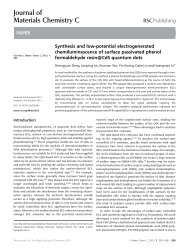Full paper
Full paper
Full paper
Create successful ePaper yourself
Turn your PDF publications into a flip-book with our unique Google optimized e-Paper software.
Multianalyte Immunoassay 7<br />
this mode sometimes suffers from signal<br />
overlapping of different labels (66).<br />
Ju et al. (61) designed a substrate zone-resolved<br />
multianalyte immunosensing system, with which<br />
HRP labeled carcinoma antigen 125 (CA 125)<br />
immunocomplex and alkaline phosphatase<br />
labeled CEA immunocomplex were sequentially<br />
detected in their corresponding CL substrate<br />
zones. This designed technique solved two key<br />
problems in multilabel mode: one was to obtain<br />
distinguishable CL signals without consideration<br />
of wavelength, and the other was to enable each<br />
CL reaction to be catalyzed by the label in its<br />
optimal assay condition without loss of assay<br />
performance. Unfortunately, as other MAIA<br />
methods based on multilabel mode, this<br />
technique encountered a difficulty to find more<br />
available enzyme labels, which limited the<br />
number of analytes. In order to overcome this<br />
limitation, this group further proposed a twodimensional<br />
resolution system of channels and<br />
substrate zones (79). Using CA 125, CA 153, CA<br />
199 and CEA as two couples of model analytes,<br />
two couples of capture antibodies were<br />
immobilized in two channels, respectively. With<br />
a sandwich format the CL substrates for alkaline<br />
phosphatase and horseradish peroxidase were<br />
delivered into the channels sequentially to<br />
perform multiplex immunoassay after the sample<br />
and trace antibodies were introduced into the<br />
channels for on-line incubation. When three or<br />
four channels were used in the flow-through<br />
device, the detectable analytes in a single run<br />
could be 6 or 8, respectively, with a 10 s longer<br />
analytical time for each added channel.<br />
3. Separation Mode<br />
Another method coupled with separation<br />
techniques such as capillary electrophoresis (CE)<br />
and high-performance liquid chromatography<br />
(HPLC) can be used for MAIA. Competitive<br />
immunoassay combined with fluorescent<br />
detection is generally adopted to perform CE<br />
based MAIA, the analytes includes abused drugs<br />
(79, 81) and peptides (82). Obviously this<br />
strategy often suffers from the adsorption of<br />
immunoreagents on inner wall of the capillary,<br />
which can be prevented by optimization of<br />
separation buffer type and pH that allowes<br />
application of high electric field (82). An on-line<br />
coupling of a label-free reflectometric<br />
interference spectroscopic biosensor to a HPLC<br />
system has been described for MAIA of four<br />
pesticides (83). In this system a highly crossreactive<br />
antibody against the four pesticides is<br />
used to bind the pesticides. The eluate of the<br />
HPLC is mixed continuously with the antibodies,<br />
and the presence of antigens is detected by a<br />
reduction of the antibody binding to the<br />
transducer.<br />
Roda et al. (84) proposed a field-flow<br />
fractionation (FFF)-CL based solid-phase<br />
competitive immunoassay, in which micrometersized<br />
beads coated with the capture antibody<br />
were used as solid phase, and analyte-HRP<br />
conjugate was used as tracer. Once the<br />
competitive immunoreaction took place within<br />
the injection loop of the system, the antibodybound<br />
tracer was separated from tracer in<br />
solution in a few minutes by means of FFF. FFFbased<br />
MAIA could be developed by use of beads<br />
with different sizes (1-50 mu), each coated with<br />
the specific antibody for one analyte. The beads<br />
could be fractionated by FFF before CL signals<br />
collection to realize detection of multiple<br />
analytes in a single run.<br />
The thermosensitive poly (Nisopropylacrylamide)<br />
(PNIP) and magnetic beads<br />
have been widely utilized as the separation<br />
carriers for immunoassays. A fast homogeneous<br />
immunoreaction as well as a simple<br />
heterogeneous separation process is carried out<br />
for MAIA in the light of some certain<br />
characteristics of water-soluble PNIP and<br />
magnetic beads, and thus, lower nonspecific<br />
affinity and higher sensitivity are accomplished




